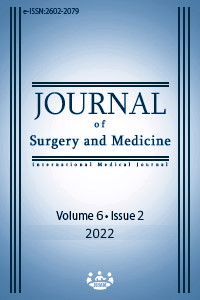Can vitamin D level be a marker for predicting risk in pulmonary thromboembolism? Comparative evaluation with pulmonary embolism severity index and CT angiography obstruction index
Keywords:
CT obstruction index, PESI score, Pulmonary embolism, 25(OH)DAbstract
Background/Aim: Venous thromboembolism is a pathological process that is among the leading causes of hospital mortality, and many studies showed that vitamin D receptors have a role in thrombosis. This study aimed to investigate the effect of 25(OH)D deficiency on pulmonary thromboembolism and evaluate the pulmonary embolism severity index (PESI). Methods: Eighty-one patients over 18 years of age who underwent CT angiography with a pre-diagnosis of pulmonary embolism were included in this case-control study. Groups 1 and 2 consisted of 45 patients with pulmonary embolism (PE), and 36 patients without pulmonary embolism, respectively. The PE patients were divided into five groups in terms of age, gender, fever, systolic blood pressure, heart rate, respiratory rate, oxygen saturation, history of chronic lung disease and heart failure, mental status, and malignancy to calculate the PESI score. Classes 1 and 2 were classified as low-risk, and Classes 3, 4, and 5 as high-risk. The CT obstruction index (CTOI) was calculated in patients with pulmonary embolism. Vitamin D levels were noted. Results: No significant difference was observed between the groups in terms of age, gender, and body mass index values (P>0.05). 25(OH)D level was significantly lower in the pulmonary embolism group (7.2(3.3) vs. 8.7(7.0), P=0.028). The CTOI was significantly higher in the high-risk patient group (P=0.019). Conclusions: The evaluation of 25(OH)D levels may be beneficial in determining the risk of thromboembolism.
Downloads
References
Misra M, Pacaud D, Petryk A, Collett-Solberg PF, Kappy M. Vitamin D deficiency in children and its management: review of current knowledge and recommendations. Pediatrics. 2008;122:398-417.
Handono K, Sidarta YO, Pradana BA, Nugroho RA, Hartono IA, Kalim H, et al. Vitamin D prevents endothelial damage induced by increased neutrophil extracellular traps formation in patients with systemic lupus erythematosus. Acta Med Indones. 2014;46:189-98.
Chiuso-Minicucci F, Ishikawa LL, Mimura LA, Fraga-Silva TF, França TG, Zorzella-Pezavento SF, et al. Treatment with Vitamin D/MOG Association Suppresses Experimental Autoimmune Encephalomyelitis. PLoS One. 2015 May 12;10(5):e0125836. Erratum in: PLoS One. 2015;10(7):e0131260.
Holick MF. Sunlight and vitamin D for bone health and prevention of autoimmune diseases, cancers, and cardiovascular disease. Am J Clin Nutr. 2004;80:1678s-88s.
Mathieu C, Badenhoop K. Vitamin D and type 1 diabetes mellitus: state of the art. Trends Endocrinol Metab. 2005;16:261-6.
Yildiz BA, Bozkurt E. The role of vitamin D deficiency and thyroid dysfunction on blood glucose regulation in patients with type 2 diabetes mellitus: A retrospective cohort study. J Surg Med.2021;5:529-33.
Khademvatani K, Seyyed-Mohammadzad MH, Akbari M, Rezaei Y, Eskandari R, Rostamzadeh A. The relationship between vitamin D status and idiopathic lower-extremity deep vein thrombosis. Int J Gen Med. 2014;7:303-9.
Wu-Wong JR, Nakane M, Ma J. Vitamin D analogs modulate the expression of plasminogen activator inhibitor-1, thrombospondin-1 and thrombomodulin in human aortic smooth muscle cells. J Vasc Res. 2007;44:11-8.
Lindqvist PG, Epstein E, Olsson H. Does an active sun exposure habit lower the risk of venous thrombotic events? A D-lightful hypothesis. J Thromb Haemost. 2009;7:605-10.
Aujesky D, Obrosky DS, Stone RA, Auble TE, Perrier A, Cornuz J, et al. Derivation and validation of a prognostic model for pulmonary embolism. Am J Respir Crit Care Med. 2005;172:1041-6.
Bertoletti L, Le Gal G, Aujesky D, Sanchez O, Roy PM, Verschuren F, et al. Prognostic value of the Geneva prediction rule in patients with pulmonary embolism. Thromb Res. 2013;132:32-6.
Wu AS, Pezzullo JA, Cronan JJ, Hou DD, Mayo-Smith WW. CT pulmonary angiography: quantification of pulmonary embolus as a predictor of patient outcome--initial experience. Radiology. 2004;230:831-5.
Qanadli SD, El Hajjam M, Vieillard-Baron A, Joseph T, Mesurolle B, Oliva VL, et al. New CT index to quantify arterial obstruction in pulmonary embolism: comparison with angiographic index and echocardiography. American journal of roentgenology. 2001;176:1415-20.
Nural MS, Elmali M, Findik S, Yapici O, Uzun O, Sunter AT, et al. Computed tomographic pulmonary angiography in the assessment of severity of acute pulmonary embolism and right ventricular dysfunction. Acta Radiol. 2009;50:629-37.
Contractor S, Maldjian PD, Sharma VK, Gor DM. Role of helical CT in detecting right ventricular dysfunction secondary to acute pulmonary embolism. J Comput Assist Tomogr. 2002;26:587-91.
Kennel KA, Drake MT, Hurley DL. Vitamin D deficiency in adults: when to test and how to treat. Mayo Clin Proc. 2010;85:752-7.
Perincek G, Hatipoğlu ON, Tabakoğlu E, Avcı S. Relation of the frequency and mortality of pulmonary thromboembolism with meteorological parameters. Acta Biomed. 2018;89:370-7.
Schöttker B, Jorde R, Peasey A, Thorand B, Jansen EH, Groot L, et al. Vitamin D and mortality: a meta-analysis of individual participant data from a large consortium of cohort studies from Europe and the United States. BMJ. 2014;348:g3656.
Cushman M, Tsai AW, White RH, Heckbert SR, Rosamond WD, Enright P, et al. Deep vein thrombosis and pulmonary embolism in two cohorts: the longitudinal investigation of thromboembolism etiology. Am J Med. 2004;117:19-25.
Entezari-Maleki T, Hajhossein Talasaz A, Salarifar M, Hadjibabaie M, Javadi MR, Bozorgi A, et al. Plasma Vitamin D Status and Its Correlation with Risk Factors of Thrombosis, P-selectin and hs-CRP Level in Patients with Venous Thromboembolism; the First Study of Iranian Population. Iran J Pharm Res. 2014;13:319-27.
Downloads
- 491 571
Published
Issue
Section
How to Cite
License
Copyright (c) 2022 Zeliha Coşgun, Emine Özsarı, Emine Dağıstan, Mehmet Coşgun
This work is licensed under a Creative Commons Attribution-NonCommercial-NoDerivatives 4.0 International License.
















